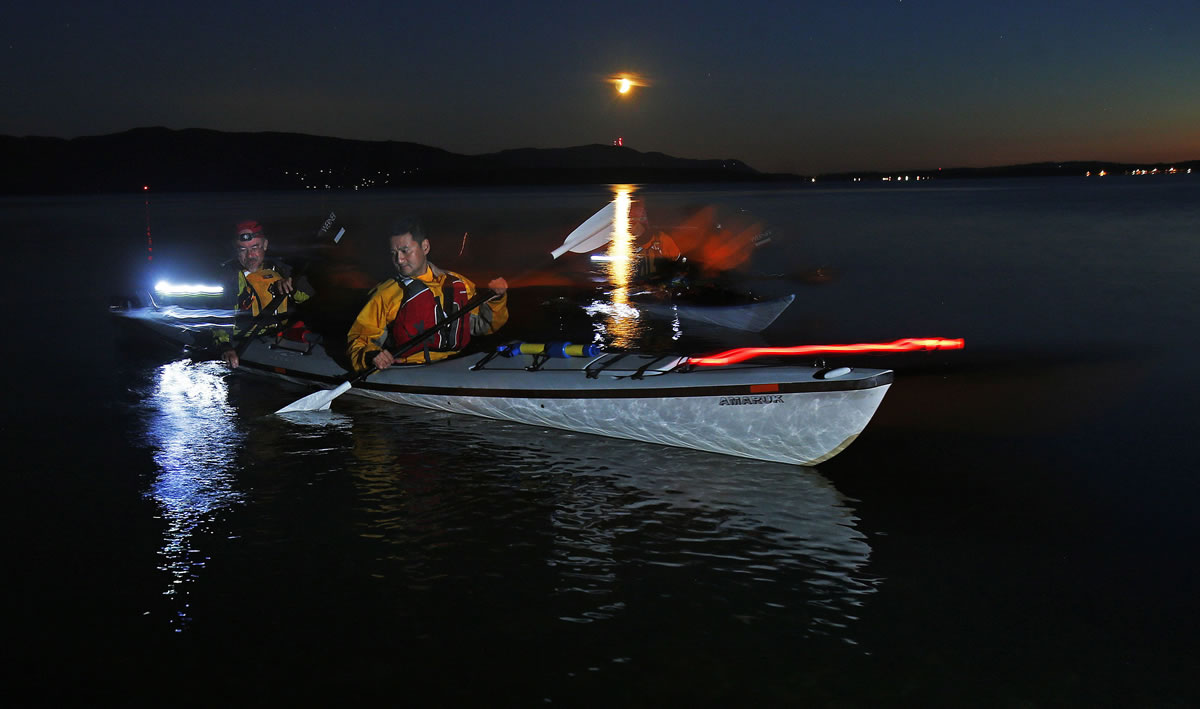BELLINGHAM BAY — Long summer evenings make for great post-dinner strolls in broad daylight, but they’re hell if you want to watch Puget Sound and the Salish Sea glow and glitter.
For that, you need pitch darkness. You need to wait hours after sunset.
By the time we set out in our kayak on Bellingham Bay, Lummi Island was a mere silhouette. And still my kayak guide, with his headlamp on, said it wasn’t dark enough.
So we paddled south to the darkest nook and cranny, until I could no longer see the ghost forest reflecting on the water’s surface.
Then it happened, these bioluminescent wonders. I stirred the water and it sparkled like Tinkerbell’s stardust.
I dragged my finger across the ripples and a faint, smoky blue streak emerged.
And when we accidentally paddled over a school of startled juvenile herring, they jumped out of the water looking like kamikaze lightning bugs.
Plankton fireworks
Earlier this summer, during the wee hours, I kayaked near Marine Park in Bellingham to check out the natural spectacle of bioluminescence, caused by single-celled planktons that emit light.
If you are lucky, these tiny organisms can put on an underwater fireworks show.
“On good nights, when there’s a lot of bioluminescence, they look like little shooting stars underwater,” said Ted Wang, who leads tours every summer. “When I was by Cypress Island, I felt you could read a book it was so bright. We had otters swimming under our boat. When they swim, they disturb the plankton and the plankton start lighting up. You could see the outline of the animals swimming underneath you. They looked like ghosts.”
The Salish Sea is prime territory to see these microscopic plankton or dinoflagellates emit light, a chemical reaction that serves as their defense mechanism when disturbed.
They’re especially visible off the coasts of Florida and California, and here, around Blake Island and the San Juan Islands, among other areas in Washington. They flash brightest from mid-July to mid-September, local experts say.
“Every time I’ve gone out in August, it’s glowing,” said University of Washington biologist Claudia Mills, who works at UW’s Friday Harbor Laboratories and kayaks around the San Juan Islands three nights a week.
“I have a kayak with foot pedals that’s like an egg beater,” said Mills. When the small organisms create these blue sparkles, “there’s all this glitter underneath my boat. Sometimes we see salmon. They are outlined in blue. You see a streak of fish outlined, moving under you.”
To catch this natural spectacle you need total darkness. The full moon is your worst enemy. The lights from a front porch or other development are bad, too. These glowing plants don’t glow as brightly as they do in the famed Mosquito Bay, in Vieques, Puerto Rico, so you need a natural black screen.
You can dip your toes from a dock or swim to get the light show going. But nothing beats the view from the cockpit of a kayak, in which you can cover a lot of ground and have a front-row seat.
Guides are good
It’s best to be familiar with the waters you plan to tour, and to be an experienced kayaker, since you’ll be paddling in the dark.
If not, consider going with a tour group or guide since you will be safer in choppy waters, far from urban lights and signs of civilization.
Tours are offered to see bioluminescence around Friday Harbor, Bellingham Bay and Seattle’s Shilshole Bay.




